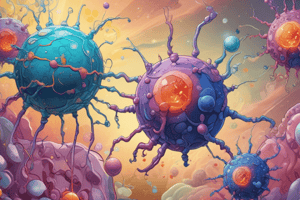Podcast
Questions and Answers
What is the basic structure of an antibody molecule?
What is the basic structure of an antibody molecule?
- Two heavy chains and two light chains (correct)
- Two light chains and four heavy chains
- Four heavy chains and two light chains
- A single polypeptide chain
What determines the specificity of an antibody?
What determines the specificity of an antibody?
- The acid sequence in the tips of the 'Y' (correct)
- The constant region
- The variable region
- The 'Y' shape of the molecule
What is the function of the constant region of an antibody?
What is the function of the constant region of an antibody?
- Determines the shape of the antibody molecule
- Determines the class of the antibody
- Determines the specificity of the antibody
- Determines the mechanism used to destroy the antigen (correct)
How many major classes of antibodies are there?
How many major classes of antibodies are there?
What is the term for the proteins related to the immune system that include antibodies?
What is the term for the proteins related to the immune system that include antibodies?
What is the approximate number of amino acids in the region that gives antibody specificity?
What is the approximate number of amino acids in the region that gives antibody specificity?
How many polypeptide chains make up an antibody molecule?
How many polypeptide chains make up an antibody molecule?
What is the term for the proteins produced by the immune system that include antibodies?
What is the term for the proteins produced by the immune system that include antibodies?
What is the shape of an antibody molecule?
What is the shape of an antibody molecule?
How many classes of antibodies are there based on their constant region structure and immune function?
How many classes of antibodies are there based on their constant region structure and immune function?
Flashcards are hidden until you start studying
Study Notes
Antibody Structure
- Antibodies are composed of four polypeptides: two heavy chains and two light chains, forming a "Y" shaped molecule.
- The variable region (110-130 amino acids) at the tips of the "Y" shape is unique to each antibody, giving it specificity.
Antibody Classes
- There are five major classes of antibodies: IgM, IgG, IgA, IgD, and IgE.
- Each class is distinguished by its constant region structure and immune function.
- The constant region determines the mechanism used to destroy antigens.
Antibody Structure
- Antibodies are composed of four polypeptides: two heavy chains and two light chains, forming a "Y" shaped molecule.
- The variable region (110-130 amino acids) at the tips of the "Y" shape is unique to each antibody, giving it specificity.
Antibody Classes
- There are five major classes of antibodies: IgM, IgG, IgA, IgD, and IgE.
- Each class is distinguished by its constant region structure and immune function.
- The constant region determines the mechanism used to destroy antigens.
Studying That Suits You
Use AI to generate personalized quizzes and flashcards to suit your learning preferences.




